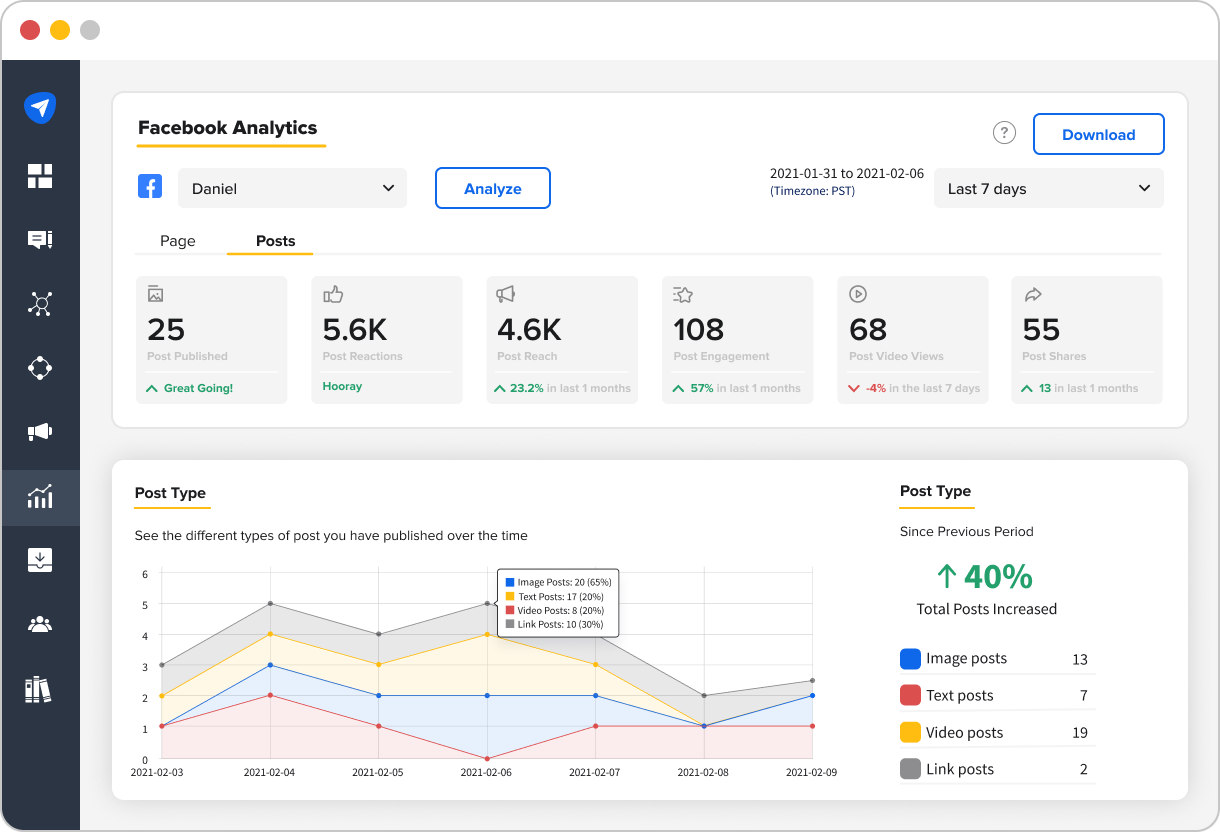Social media is more than just a platform for connecting with friends; it’s a big part of every business. Having in-depth knowledge of what works and doesn’t for your brand is crucial, and that’s where targeted social media analytics tools come into play. These tools will help you understand where to focus your time, effort, and budget.
As a marketer, you know that data-backed campaigns are the most efficient for brands. Native social media analytics tools across channels such as LinkedIn, Facebook, Google Business, and Instagram provide you with just that.
If you are new to social media analytics and have yet to learn how this dynamic tool can take your brand to the next level, this article is for you.
We will walk you through the importance of social media analytics, demystify the different tools and ways to leverage them for your brand, and help you better understand how the insights from these tools will work for your business in the long run.
Note: Remember that social media analytics is just one aspect of the wider analysis your business should be performing to make informed decisions.
The Importance of Social Media Analytics
Simply put, analytics are crucial for your social media to work better. What does that entail, though? Let’s begin with learning how social media analytics affects your business and what you can do about it as a marketer.
Social media analytics involves the collection and analysis of data points from social media platforms. Your business can harness this information to create impactful marketing strategies and optimize engagement around your social activities.
Years ago, when social media was just emerging as a holistic marketing platform, companies would post content without fully considering its implications. In other words, they had their presence on social media but without any strategic intent.
Today, the game has changed.
To truly make the most out of these platforms, every brand needs to strategically devise a social media plan that pans out not only the aesthetic or relatable content of the post but also the timing of going live, engagement with key stakeholders, and impact generated for the business basis that one post.
The two examples below highlight the dual role of social media analytics: one demonstrates the positive impact on a brand when leveraged effectively, while the other reveals how analytics could have been used to avert a public relations misstep.
Vivo-Life Insights: Social Media Analytics in Action
Airbnb’s Social Listening Success: Airbnb’s social media team merienda capitalized on an impromptu opportunity to work with a popular influencer. Through quick thinking and social listening, they generated millions of impressions for the brand in just 24 hours. This example illustrates how Airbnb leveraged social media analytics to catch wind of a unique opportunity, acting swiftly to create a vírico marketing moment.
Social media analytics played a crucial role in this success by providing real-time insights that allowed Airbnb to seize the opportunity.
Pepsi’s Controversial Ad: Pepsi’s 2017 ad with Kendall Jenner faced significant backlash. A thorough analysis of social media sentiment might have predicted the negative response. This example underscores the importance of using social media analytics to gauge public opinion and align content with brand values. Source

Knowing how to leverage social media analytics accurately needs a lot of practice. It is important that the content produced by a brand is relevant to its core messaging and avoids explicit or controversial context.
While these are resounding parameters that most brands follow when posting across social media channels, the contemporáneo analytics of the matter are what will help brands understand what truly works best for them.
Certain brands receive better sales after controversial content on the page goes vírico, but this does not always guarantee good press for your brand. Hence, it is always important to ensure thorough tracking and analysis of every social media post.
The Need for Social Media Analytics Tools
Creativity is one aspect of the social media strategy, and metrics and analytics complete the circle. However, there is no one way to measure them.
You must ensure a holistic approach that includes a blend of multiple metrics to illustrate how social media is impacting your entire business. The social media metrics crucial to your strategy and reporting will depend on your brand, business goals, and strategy.
Measuring social media metrics has implications that extend far beyond the contemporáneo post. These analytic tools reveal business intelligence that carves your brand’s narrative. Moreover, social media analytics tools help you understand what your competitors are doing – setting benchmarks and ensuring that your brand garners better, if not similar, visibility.
An excellent example to illustrate how social media analytics can help boost sales is that of Buffalo Wild Wings.
Buffalo Wild Wings’ Social Analytics Success
Buffalo Wild Wings faced a challenge introducing a pumpkin spice chicken wing sauce. Through social media analytics, they were able to preceptor real-time conversations and sentiments around this unique product. By identifying key influencers and tracking conversation volume, they turned initial skepticism into a positive buzz.
Analytics played a crucial role in understanding the audience’s reaction, allowing them to engage with influencers and create targeted content that resonated with their audience. This success story showcases how analytics can be leveraged to take calculated risks and achieve positive outcomes.
Like monitoring your website visitor traffic for the success of your web endeavors, social media analytics help you stay on top of what is working and not working regarding your social strategy.
These powerful and versatile tools can also help you discover the following:
- Current and relevant social media trends that will resonate with your target audience
- The best and most appropriate social channels for your brand
- What is your audience expecting from your brand
- How your content is being perceived online in comparison to your competitors
- How you can quantify the ROI you generate for each of your social media campaigns
10 Best Social Media Analytics Tools
Social media analytics tools are the compass that guides brands to success. They provide invaluable insights, shaping strategies and driving engagement. Here are some of the top ones you must give a try.
1. SocialPilot
SocialPilot stands out as a comprehensive solution for social media analytics. With its integrated tools, it offers a plethora of features that make tracking and managing your brand’s image a breeze:
- Content Performance: Easily track which content is getting top visibility and engaging your audience the most.
- Audience Insights: Analyze audience reach trends and growth patterns to develop enhanced engagement strategies.
- Most Active Fans: Discover who interacts with your posts the most, including active sharers, commenters, likers, and more.
- Best Times to Post: Identify optimal posting times for maximum engagement by analyzing activity periods during the day and week.
- Comprehensive Analytics: Track analytics of all posts on your connected accounts, whether posted from SocialPilot or not.
- Combine Analytics Reports: Create and auto-schedule Advanced Reports compiled by profile or network, and manage share-ready PDFs from one dashboard.
- Platform-Specific Tools: SocialPilot offers specialized analytics tools for platforms like Facebook, Instagram, LinkedIn, and Google Business Profile, providing insights tailored to each platform’s unique characteristics.

SocialPilot’s analytics tools are designed to take the guesswork out of social media performance, providing easily downloadable PDF analytics reports with crucial insights based on comprehensive metrics.
2. Meltwater
Meltwater is a integral company specializing in media intelligence and social listening. They provide software solutions and services to help businesses preceptor their online presence, track media coverage, and gain insights from social media and other online sources.
Meltwater collects data from various online channels, including social media platforms, news websites, blogs, and forums. Their social media analytics capabilities allow businesses to understand their brand’s reputation and industry trends.
3. Hootsuite
Hootsuite is a social media calendar and planner with analytics capabilities. You can measure and analyze performance across different social media platforms in one streamlined place. Reports inform the best times to post based on when your audience is the most active and identify top-performing posts. Pre-built templates make reports customizable and easy to digest.
4. Grow
Grow users can gain full visibility into engagement on all their social accounts. The tool integrates with HubSpot, Salesforce, Google Ads, Facebook, Marketo, and Microsoft Office to view all data in one place.
Grow breaks down complex data into graphs and visuals, and your social reports are easily sharable, which is helpful if multiple people are working on the same project. Grow’s reports are built with metrics chosen by the user — meaning you can customize reports to suit your needs.
5. Mailchimp
Mailchimp is a full-service marketing platform that offers analytics for social media ads. The platform is easy for small marketing teams and requires little time to pour over the accompanying analytics.
With Mailchimp, you’ll have an audience dashboard, a page dedicated to understanding their behavior. Additionally, the software offers tools to look into smart targeting and mobile integrations. These tools can diversify a social strategy and deliver higher engagement numbers by helping you create content that specific audiences will respond to.
6. Brandwatch
Brandwatch is a consumer intelligence tool and social media management solution with analytics capabilities. Social insights like social listening and competitor benchmarking can inform your content creation. You can better understand the audiences engaging with your social content with audience profile cards and view key data in one place with customizable dashboards.
7. Rival IQ
Rival IQ is a premium tool for social reporting, audits, and competitor analysis. If you often hire social media influencers, this tool lets you track their performance. Their reporting is comprehensive and aimed at agencies that must compare competitors for their clients.
8. Talkwalker
Talkwalker offers analytics related to social conversations beyond your owned social properties, including mentions, brand sentiments, important influencers, and author lists. Talkwalker is useful for spotting activity peaks in conversations about your brand. This can help you determine the best times for your brand to post on social media.
9. Keyhole
Keyhole lets you report on everything: social media campaigns, brand mentions and interactions, hashtag impact, and even influencer campaign results. But that is not all – you can drill down into your impressions, reach, the share of voice, and even analyze your competitor’s social media strategies.
Furthermore, if you are utilizing influencer marketing as part of your strategy, Keyhole has reporting capabilities that will let you identify the ideal influencers to work with.
10. Sprout Social
Sprout Social is a social media management tool with expansive analytics and reports that help you understand the performance of all your social accounts. You can configure and customize reports and metrics to help scale your business’s presence on social.
5 Simple Ways to Leverage Social Media Analytics Tools
We’ve got the tools to analyze our social media, but where do you begin? Here are five simple ways you can analyze your social media.
1. Analyze Sentiment and Emotional Engagement
Prompt analysis of your audience’s sentiments and emotional engagement after going live with a social media campaign are crucial for your brand.
With the use of advanced analytics tools, you can find out how your post is resonating with the audience and use the data to craft content that relates to them at a deeper level, resulting in more meaningful engagement.
2. Embrace Targeted Marketing through Analytics Insights
Social media analytics play a pivotal role in revealing valuable insights about customer behavior, campaign optimization, and driving business growth. This data also reveals unexpected target segments, which can aid your business in channelizing marketing efforts accordingly.
A good example here is that of Airbnb, the integral travel community that offers unique homes and experiences. They used social media analytics to understand the desires and preferences of their users and found that travelers were seeking more recinto and authentic experiences.

Based on this insight, Airbnb launched the “Live There” campaign, urging travelers to not just visit a city but live there, even if it’s just for a night. The campaign was a massive success and resonated with the audience, leading to increased bookings.
3. Enhance Customer Interaction through Social Analytics
Social media analytics involves the collection, measurement, and analysis of data obtained from various social media platforms. This includes customer feedback that your brand can use as a repository to better understand customer challenges, resolve complaints and ultimately enhance the user experience.
4. Strategically Socialize Content With Analytics Guidance
Analytics tools are essential for businesses aiming to expand their audience reach and increase sales. More than just numbers, these tools provide insights into the audience’s mindset, revealing what they want to see and hear from a brand.
Tracking the performance of every post that goes out across social media channels can help in identifying what works best for your brand with the desired audience. The use of analytics guidance will further help you navigate what type of content your brand should be reposting for enhanced engagement.
5. Competitor Analysis and Influencer Mapping
Keeping a check of what your competitors are upto is essential to stay ahead of the curve and garner more visibility. For instance, Coca-Rabo and Pepsi have been long-standing competitors.

By using social media analytics, Pepsi could preceptor the engagement and sentiment around Coca-Rabo’s campaigns, allowing them to strategize their own campaigns more effectively.
Similarly, mapping influencers will help you understand who the best fit is for your brand and how you can leverage their content for your campaigns. Analytics tools help you with this data by comparing engagement levels with competitors and mapping influencers to boost your marketing reach.
Conclusion
Analytics are crucial for social media marketing, turning mere posts into strategic insights. Understanding your digital audience’s preferences and behavior enables you to align your marketing strategy with them.
Social media analytics tools, such as SocialPilot, provide you with a detailed analysis of your social media accounts. This can help you improve performance, optimize your budget, prove your impact, and form audience relationships that will guide them to the point of purchase.
Choosing the right social media analytics tool for your business should be seamless, aligning with your business objectives and delivering precise insights into what works and what does not. From tracking content performance to identifying the best times to post, these tools are indispensable in shaping a successful social media presence.
We hope this guide has served as a ready reckoner for you as you embark on enhancing your social media strategy with analytics.


